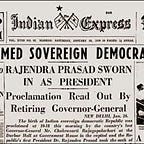The National Identity XXXV: The Three Indian Armies
The grand 150-year Bengal, Bombay, and Madras calculus
There isn’t a theatre of war in the 20th century that the Indian Army hasn’t seen action in. As part of the British Empire — the Indian Army were the guarantors of peace in the region stretching from East Africa and the Middle East to Singapore — including modern day Eritrea, Iran, Iraq, Israel, Palestine, Afghanistan, Pakistan, India, Nepal, Bangladesh, Bhutan, Myanmar, Thailand and Singapore. They were even deployed in China in 1860 and 1900. Till the turn of the 19th century, however, decades after the momentous events of the 1857 First War of Independence — there were three “Indian” Armies in existence — Bengal, Bombay and Madras. This arrangement continued till 1895 when these armies began to be merged and, finally, in 1903 the Indian Army came into existence. It is largely the Bengal Army which survives today, without a Bengal Regiment.
1| Close Encounters of the First Kind
The first European brush with various Indian army-men left them distinctly unimpressed. During the initial exchanges with the Mughal Empire, the British and the French relied on Indian irregulars. The experience of battle taught them that these domestic soldiers had to be drilled and trained in combat to stand any chance of competing with…
